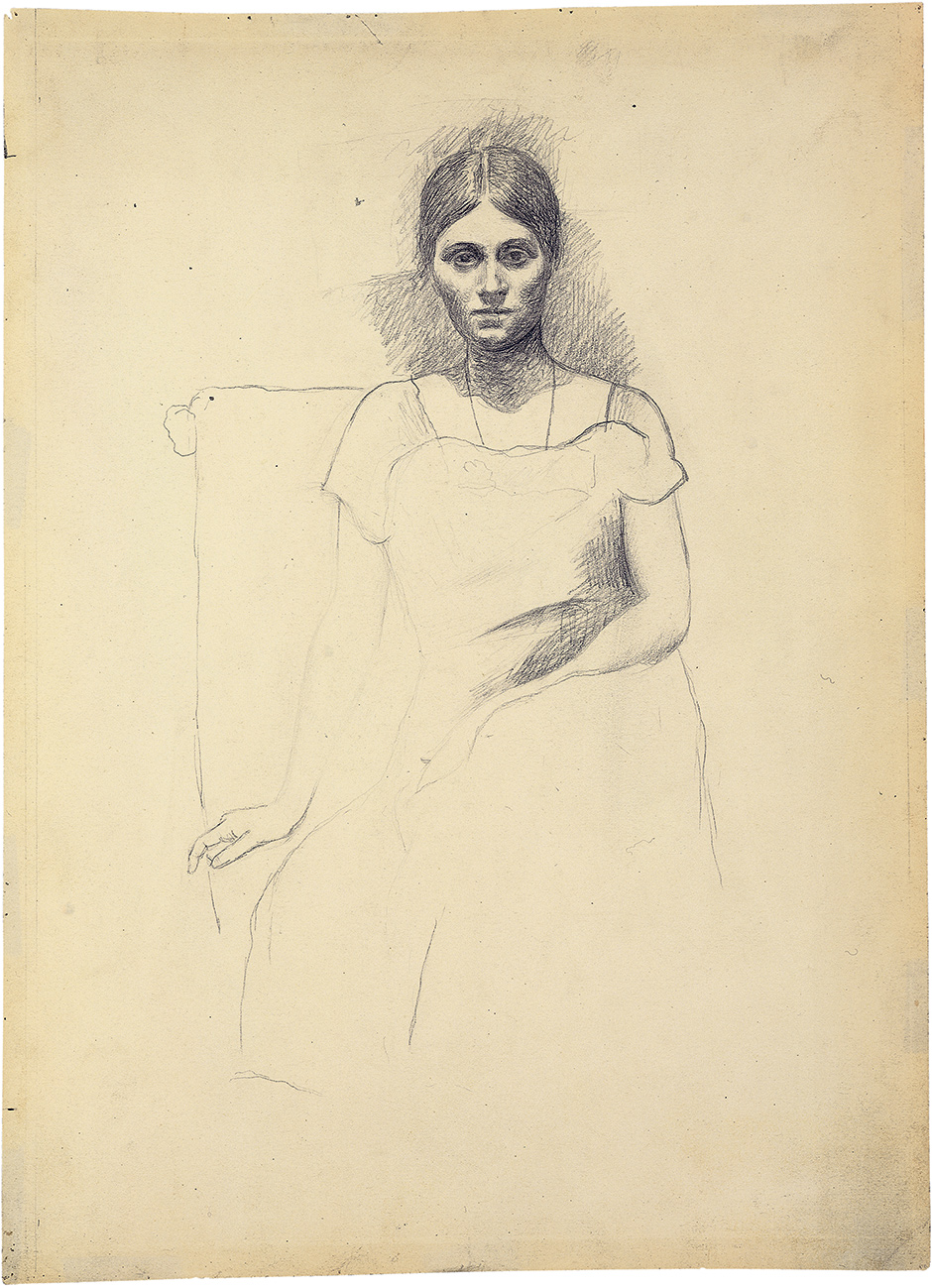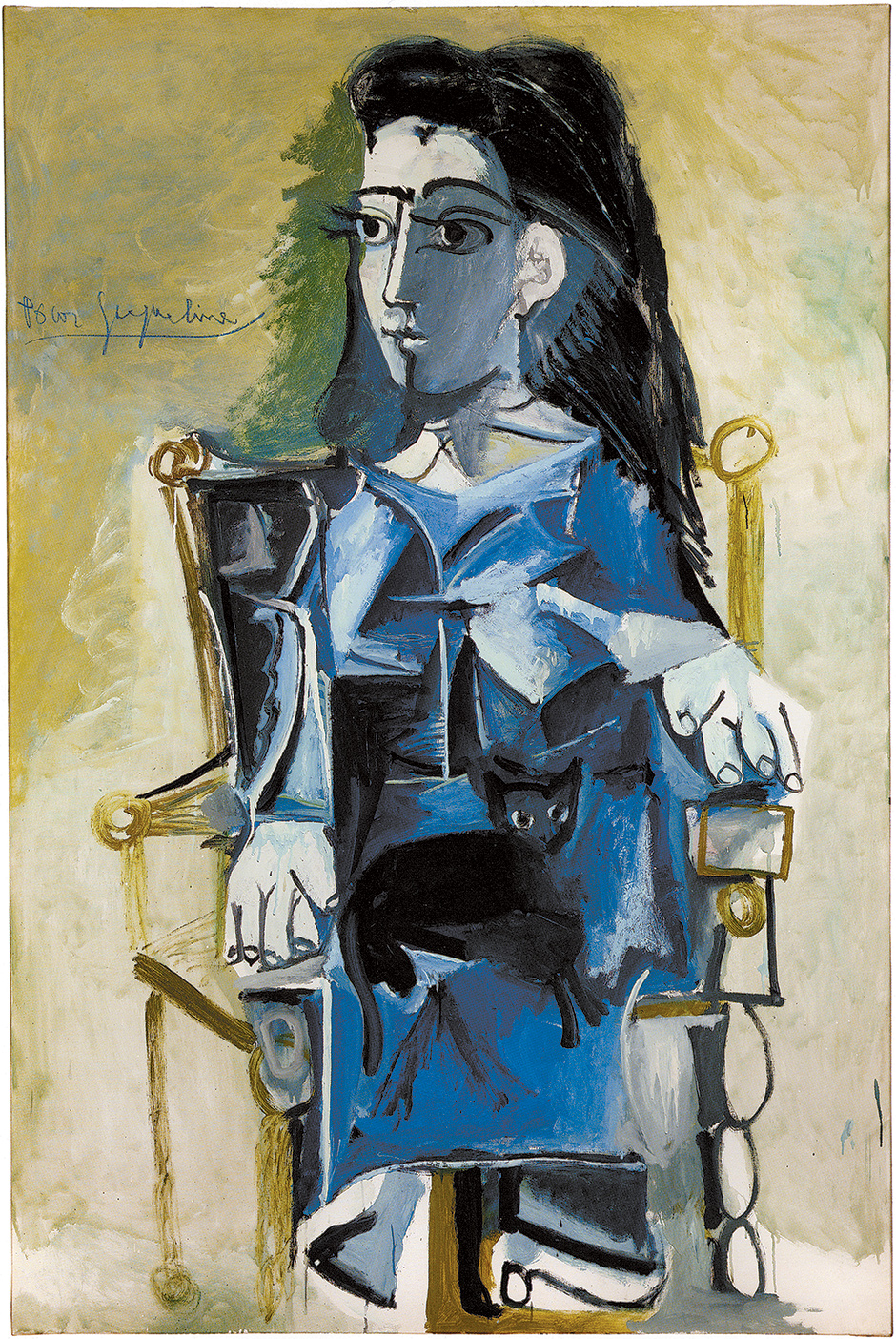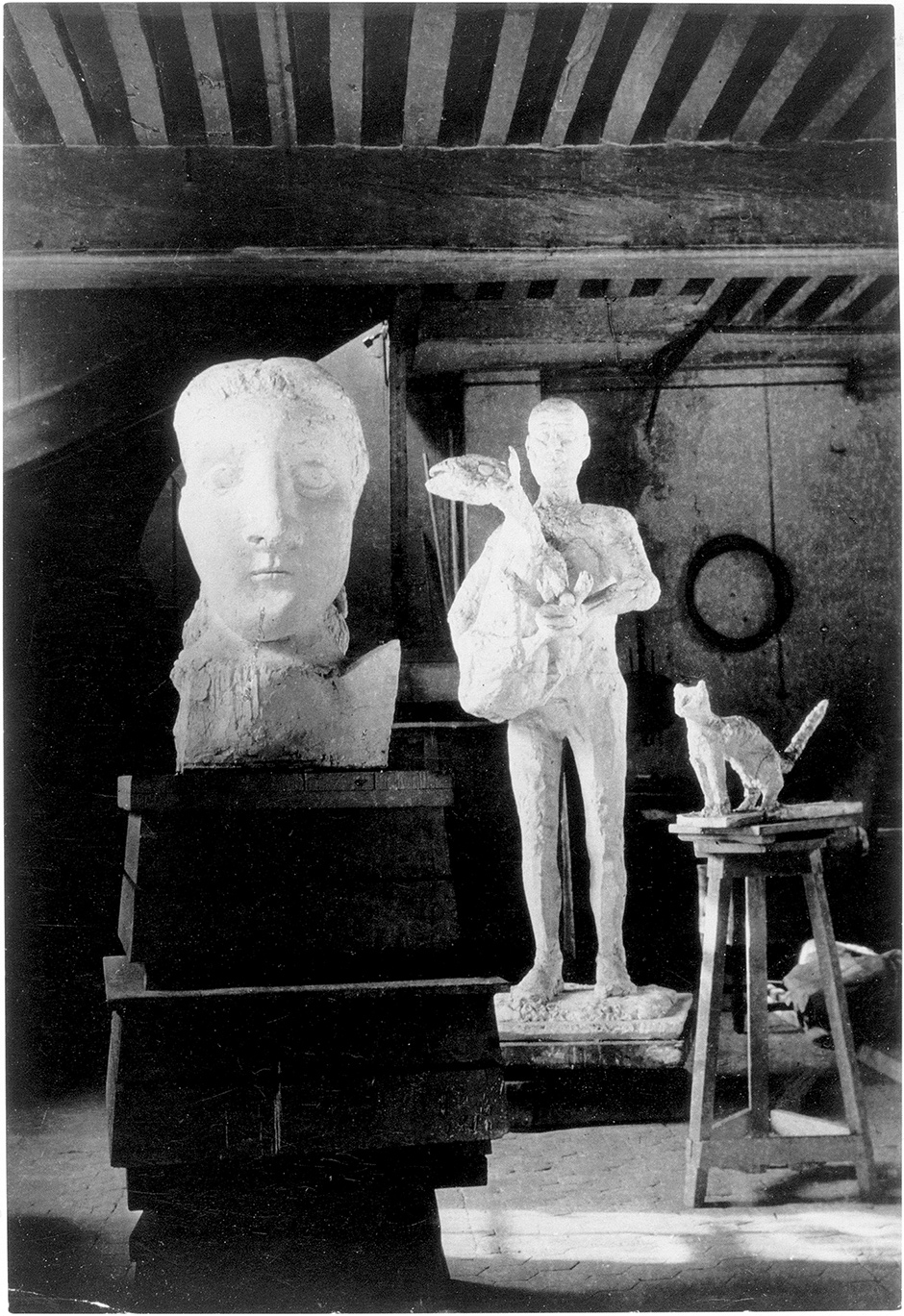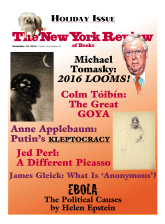No artist has ever embraced the freedom of the imagination with more fierce, hell-bent intensity than Picasso. In the generation since his death in 1973 at the age of ninety-one, modernism has given way to postmodernism and posthumanism, and through it all Picasso has somehow retained his heroic standing, still the virile Nietzschean hero with the X-ray eyes. Artists, curators, critics, and museumgoers will disagree about the quality of one or another aspect of his epochal output. But anybody who walks through the Musée Picasso in Paris, just reopened after a five-year renovation, or through the enormous exhibitions of Picasso’s work currently on view at the Gagosian and Pace galleries in New York will probably experience something like the adrenaline rush that Picasso’s earliest admirers knew in the years before World War I.
By now Picasso’s freedom may look like a glorious fluke not only of art history but of history itself, a product of the expanding democratic cosmopolitan culture of the final years of the nineteenth century and the first half of the twentieth century. Those seventy-odd years were a time when even the most nihilistic members of the avant-garde remained on close enough terms with the academy to see what the old verities had to offer. And the violent face-offs between high culture and popular culture that in our own day seem to immobilize the art world remained healthy disagreements, provoking creative sparks, insights, revelations. The increasingly open society in which artists and writers were living stimulated the openness of the arts, and Picasso was willing to go for broke, precipitating the radical antinaturalism of abstraction and embracing the topsy-turvy naturalism of Surrealist dreams.
Wherever Picasso turned, he brought deep insights and dazzling aplomb. He discovered in the pluralism of modern society a crazy-quilt theatricality that he could turn inward, revealing the essentially multifaceted nature of the individual. We still live in that pluralistic society, but we are no longer rising with it so much as we are overwhelmed by it, unable now to understand how Picasso could embrace so many divergent, kaleidoscopic possibilities.
To have had the good fortune to see in a single week, as I just have, Picasso’s life work on display in Paris and New York is to be reminded all over again what a genius could achieve when a cosmopolitan culture was at its zenith. The welcome news from Paris is that the Musée Picasso’s idiosyncratic magic has emerged intact after renovations that significantly expanded its size. This great collection of Picassos, given to the French state in lieu of taxes after the artist’s death, looks as splendid now as when it was originally installed in 1985 in a mansion in the Marais.
Meanwhile in New York, gallerygoers are the beneficiaries of a competition between two blue-chip galleries, each appealing to collectors interested in buying or selling Picassos. “Picasso and Jacqueline: The Evolution of Style,” the doubleheader mounted by the Pace Gallery in its spaces on East 57th Street and West 25th Street, marshals paintings, drawings, prints, and sculpture to explore the changing image of Jacqueline, Picasso’s second wife and last great love, whose dark, compact beauty dominated his art in his final twenty years. On 21st Street, “Picasso and the Camera” is the fifth Picasso exhibition that John Richardson has organized for the Gagosian Gallery, while he works on the final stages of his definitive biography. Richardson’s exploration of Picasso’s lifelong fascination with photography is presented with a curatorial graciousness, intellectual sobriety, and visual perfect pitch that set a very high standard.
The effect of these exhibitions is exhilarating. However distant we may now feel from the halcyon days of modern art, there are apparently enough people who respond to the old magic that it remains possible to rekindle it, at least in a curatorial spirit on the walls of a museum or a gallery. We see Picasso almost simultaneously pushing to the brink of abstraction and exulting in the pleasures of a spine-tingling realism—and everywhere we turn, we realize that for Picasso the key to the creative act was its essentially dialectical nature.
Whatever Picasso made provoked questions and revelations that pushed him to make something else, to go in a different direction. This artist, who almost invariably embraced the real rather than the ideal, had no interest in the Hegelian dialectic, with its strenuous search for spiritual essences. He had an essentially Mediterranean sensibility, his creative processes closer to the Socratic dialectic, with its open-ended attitude of questioning and questing—and its refusal to draw some fast distinction, or indeed any distinction at all, between the allure of the love object and the pursuit of the life of the mind.
Advertisement
A great deal has been written in the past year or so about the personality conflicts and scheduling delays involved in getting the Musée Picasso, closed since 2009, reopened to the public. Although Anne Baldassari, the museum’s director, was ousted from her job and a new director, Laurent Le Bon, was brought in, Baldassari prevailed insofar as she has been able to oversee the initial reinstallation. Whatever the interest of all these conflicts for art world insiders, what should matter to the public is that the project has been safely brought to completion.
The galleries have been significantly expanded, especially with the opening of the third-floor spaces, their elegant, roughhewn beamed ceilings beautifully restored, and currently containing Picasso’s collection of works by Cézanne, Degas, Le Douanier Rousseau, Matisse, Balthus, and other modern masters. The overall character of the Musée Picasso remains happily unchanged. Now as in the 1980s, the spirit of the place is absolutely loyal to Picasso, a modern artist who liked to live and work in old spaces and would have certainly approved of this seventeenth-century hôtel particulier, with its splendid Baroque staircase, elegantly proportioned rooms, and quirky basement chambers. Diego Giacometti’s wonderful chandeliers and furnishings are still in place. As for Baldassari’s selection and arrangement of the inaugural exhibition, it naturally features many of the museum’s greatest treasures—principal works from nearly every period and an unrivaled trove of sculpture.
The truth is that whatever a curator chooses to do with the Musée Picasso’s holdings, the strongest impression will always be of a collection curated by Picasso himself. He kept these particular works, frequently close at hand, in his studios and storerooms. And the greatest among them, such as the 1931 Large Still Life with a Pedestal Table that is a veiled portrait of his lover Marie-Thérèse Walter—included in Picasso’s Masterpieces: The Musée Picasso Paris Collection, edited by Baldassari—often show his art at a turning point, when a new discovery is rapidly ripening.
At the time of Picasso’s death, sophisticated viewers, especially in the United States, were still inclined to locate the pinnacles of his achievement in the Rose Period, the Cubist paintings and collages, and perhaps the scrambled physiognomies of the years leading up to and away from Guernica. The opening of the Musée Picasso in 1985—a dozen years after the artist’s death and five years after the epochal Museum of Modern Art retrospective—encouraged a wide-ranging reconsideration of the relative value of Picasso’s various periods, modes, and manners, a reconsideration that has gone on ever since. By now he seems not so much a quintessentially modern artist as an artist who stands outside of time, following his own private concerns, which as frequently link him to El Greco, Velázquez, Rembrandt, and Degas as to any of his contemporaries.
The Musée Picasso contains a great many works that shake up all the received wisdom about the highs and lows of his career. They range from the crisply sensuous 1918 portrait of his first wife, Olga, holding a fan, to the very late Mother and Child (1971), with its Romanesque gravitas. If the 1980s were a time when Picasso’s works seemed to suggest many divergent directions, my reaction on revisiting the Musée Picasso is that we are beginning to grasp how his dozens of styles, modes, and manners are knit together. A little over forty years after Picasso’s death we are perhaps for the first time seeing him whole. What ties together everything he did is his appetite for visual drama, and his tendency to favor these multiplying dramatic inventions over a smaller number of more fully established visions.
While this dramatic disposition has endeared Picasso to some viewers, it has frustrated others. Among artists, you will often hear it said that Picasso is not as important a painter as Matisse or Braque or Bonnard, who are seen as resolving ideas where Picasso is content to suggest or play around with them before moving on. However one may come down on this question, we can be sure that Picasso would not be Picasso were he not always angling for some fresh visual drama. That hunger ignited the fever and melancholy of the Blue and Rose periods, transformed the afternoon light of Montmartre studios and cafés into the pewter-and-silver sonorities of Cubism, and from time to time even provoked pastoral reveries in this most restless of men, a fine example at the Musée Picasso being the luxuriant, green-on-green variation on Manet’s Déjeuner sur l’herbe, which Picasso completed in August 1960.
With each successive stylistic turn, Picasso restaged his primal dramatic urge, simultaneously breaking and remaking the world as he knew it. Everything he did, while to an astonishing and even aggressive degree an assertion of the self, was to an almost equal degree a response to the drama of the world around him—the dramatic power of lovers, friends, still lifes, landscapes, or (certainly in the case of Guernica) current events. This double-barreled drama is visible at the Pace Gallery’s exhibition “Picasso and Jacqueline,” which brings together nearly all the most celebrated paintings of Jacqueline, along with a considerable number of drawings, prints, and sculptures.
Advertisement
Over a period of some twenty years, Picasso focused on one or another aspect of Jacqueline’s physiognomy: the long neck, the classical nose, the almond-shaped eyes. The neck was imagined as a column, a pedestal, a stem. The relationship between the strong nose and the dark eyes was studied in profile and full face, the architectonic counterpoint of straight line, arc, and circle subjected to endless variations. Obsessed with Jacqueline, Picasso reimagined her time and again, employing his entire arsenal of stylistic tropes, from soft classicizing modeling to tough geometric crystallization. When he painted a series of variations on Delacroix’s Women of Algiers, he saw Jacqueline as a Romantic heroine, and so there were impressions of her in elaborately decorated jackets and headdresses, the enigma of her eyes doubled by the enigma of a costume.
All of this was in turn played against the changes that time inevitably wrought on her face and figure, which was wonderfully lithe when he first drew and painted her in 1954, a little more thickset a decade later in Jacqueline Seated with Her Cat (its blues perhaps evoking the Blue Period of fifty years earlier), and finally fantastically voluptuous when she was summoned up in the great etchings of 1969 and 1970. In the last years Jacqueline was no longer Jacqueline but something more like Everywoman.
John Richardson’s “Picasso and the Camera” offers yet another way of understanding Picasso’s explorations of the relationship between the self and the world, his vision for all its solipsism as much outward-turning as inward-turning. Granted such demonic curiosity, Picasso could hardly have avoided the fascinations of the camera eye. “Picasso and the Camera” is that rarest of gallerygoing experiences—an exhibition packed with ideas in which the ideas never overshadow the art. Mounted in one of Gagosian’s capacious spaces in Chelsea, it is a three-ring circus that somehow goes off without a hitch.
Ranged around the four walls is a survey of paintings and drawings covering much of Picasso’s career, many of them relatively small, a few of them revelatory. The photographs—often by Picasso himself, some by Brassaï, Dora Maar, André Villers—are mounted on display stands around the room, so that their particular qualities are set in a counterpoint rather than a direct confrontation with Picasso’s paintings and drawings. In the center of the room, in what amounts to a room within a room, there are films in which Picasso appears. We see Picasso’s natural physical grace on display, in rare 1930s home movies, in a color film by Man Ray of Picasso cavorting with friends around 1937, and in later studies of the artist at work, including Henry-George Clouzot’s 1955 Le mystère Picasso, in which we watch as Picasso draws a Côte d’Azur landscape on the other side of a large sheet of glass.
John Richardson’s Picasso biography—three volumes have already been published—is that rarity among the lives of visual artists, a work of literary originality. Richardson is a born storyteller who approaches the tapestried richness of Picasso’s life with a dispassionateness that is also somehow loving, so that the life and the art are woven together with clarifying force, the blur of hagiography swept away. The exhibitions Richardson has organized for the Gagosian Gallery—beginning with “Mosqueteros” in 2009—are blockbuster events brought off with the same invigorating scrupulosity we know from the biography.
Even so, I had worried before seeing “Picasso and the Camera” that in wading into the subject of Picasso and photography, Richardson risked downgrading the Spaniard’s artistry and overemphasizing the quick thrills photography can offer. I need not have had any doubts. Richardson refuses to overplay his hand. He sees photography as refining or clarifying or gently expanding Picasso’s imaginative reach, whether early on when Picasso saw in photography some inklings of Cubist geometry or late in life when he styled himself something of a prepackaged icon for photojournalists.
What Richardson demonstrates is the extent to which for Picasso, the camera and the images it produced created further opportunities for dialectical play, whether he was photographing his own sculptures of the early 1930s to study latent potentialities in unfinished works, or inviting Brassaï to photograph the same works dramatically, before they were introduced to the world in the pages of the Surrealist magazine Minotaure. Richardson, always the enemy of cut-and-dry theory or glib conclusions, may want to suggest that Picasso’s ravishingly refined Neoclassical drawings and paintings of Olga from 1917 on were fueled by a desire to rival the silken smooth surfaces of the photographic image.
Later, Picasso collaborated on photographic experiments with his lover Dora Maar, herself a significant Surrealist photographer. And later yet, Picasso worked with André Villers, creating cut paper masks that were superimposed on landscape photographs for what ultimately became a portfolio of collotypes titled Diurnes (1962), a work Richardson believes has been too little studied. Far from presenting the camera as an instrument that for Picasso might ever displace the artist’s hand, with “Picasso and the Camera” Richardson argues that it was one more way to challenge and embolden the artist’s hand.
Picasso as he emerges at the Pace and Gagosian galleries and at the Musée Picasso is less the pioneering modernist of Cubism than a figure unto himself, certainly alert to history in all its forms, but intent on shaping those experiences through the particulars of his own experience, which is inevitably a personal history. In what is perhaps his most famous statement, made in 1923, Picasso rejected the idea of his art “as an evolution, or as steps toward an unknown idea of painting.” “To me,” he said, “there is no past or future in art. If a work of art cannot live always in the present it must not be considered at all.” Cubism, Picasso said, was not “an experiment which is to bring ulterior results,” but an art that was meant to “live its own life.” And that is what we see in Picasso’s art today—an art that is living its own life.
If Picasso’s achievement suggests a great spiral or cycle of self-invention and reinvention—a process without linear progress or evolution—this makes him an especially appealing artist for us now, when most ideas about progress have failed or nearly failed. If there is a key that unlocks Picasso’s achievement, it is to be found neither in the Marxists from Max Raphael to John Berger who measured his achievements against the social and economic vagaries of his times, nor in the formalism of Clement Greenberg, who viewed Cubism and the onset of abstraction as a revolution that Picasso precipitated but that eventually left him behind.
It was rather Meyer Schapiro, in his essay “The Unity of Picasso’s Art,” who grasped Picasso’s essental nature. Schapiro emphasized Picasso’s zigzagging transformations, “from the reality to an abstraction; from an abstraction into a reality”—and the way that, through the powerful actions of his hand, Picasso possessed these transformations. “He has become strong in the processes of art,” Schapiro argued, “and that strength is the outcome, the sign, of this perpetual transforming process.”
Progress, at least in modern art, has often been related to ideas of purification, simplification, and reduction. Picasso was never committed to any of that, at least not for long. Sometimes he simplified, but as frequently he complicated. For Picasso, Cubism was as much complication as simplification, as much a matter of feeling as of form, the world comically and tragically disassembled and reassembled. Neoclassicism’s porcelain- perfect verisimilitude was as natural an outcome as the abstract web of the 1928 design for a monument to Apollinaire. If Picasso’s work strikes with particular urgency now, it is because his skepticism about the promise of progress and his heartfelt and disorderly humanism accord with our moment, when we often feel that the best we can do is to take things as they come, the tragic and the comic bewilderingly mixed. Like Picasso, we do not see catharsis in the old modern dream of progress.
A product of modernism, Picasso trumped modernism. By rejecting the idea of art as having a past or a future, he has somehow managed to stay with us in the present. Going through the rooms full of Picassos in New York and Paris, confronting at every turn the faces and figures of his lovers and friends and mythological imaginings, we find ourselves happily besieged by humanity in all its crazy, wonderful, awful profusion. For those who had imagined that Picasso would recede with the modern century, there is quite a shock in finding that he is right here beside us as we stand blinking in the harsh light of the day after modernism died.
This Issue
December 18, 2014
The Dark & Light of Francisco Goya
How He and His Cronies Stole Russia






